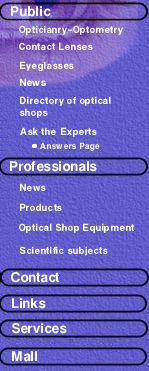|
Low Vision
Some people cannot see the things they need to
see even though they are not blind. Their problem is low vision.
Low vision refers to impaired vision that does not improve through
medicine, surgery, or ordinary corrective lenses. Individuals with
low vision find it difficult or impossible to do many everyday tasks.
For example, they may be able to walk unaided but not see someone's
face.
What are the symptoms of low vision?
Low vision is not blindness, which is the absence
of useful vision or light perception. Persons with low vision may
see light, color, movement, dimension, shape and size. However,
things can appear blurred, faded or distorted. Objects may seem
to be "jumping about" "not all there" or "not there at all."
A person's visual acuity-the ability to see fine
detail-can worsen. There can be a narrowing or loss of parts of
the visual field-the area of sight. Someone with low vision may
be less sensitive to differences and changes in brightness, contrast
and color. Adaptation to high or low levels of light may be slowed
or impossible. Various combinations of these changes in vision can
occur.
How many people have low vision?
Nearly 2 million people are severely visually
impaired and cannot read ordinary newsprint even with reading glasses,
according to projections based on 1986 data from the National Center
for Health Statistics. Another 6 to 9 million people have impaired
vision that may interfere with their ability to perform some activities.
About 77 percent of severely visually impaired people are at least
65 years of age. Many of these persons have other physical problems;
low vision often can be the crucial factor that prevents them from
living independently.
About 77 percent of severely visually impaired people
are at least 65 years of age. Many of these persons have other physical
problems; low vision often can be the crucial factor that prevents
them from living independently.
What causes low vision?
Eye diseases, eye injury or aging of the eye
may disrupt normal visual function and result in low vision. Visual
complaints differ depending on which part of the visual system is
damaged. Inability to do an activity depends on whether the problem
affects side vision, central vision or both.
Distortion or loss of central
vision can occur in age-related macular degeneration-the leading
cause of new cases of legal blindness in people 65 and older. In
this disease, there is a progressive breakdown of the macula-the
central part of the retina that permits the greatest perception
of detail and color. Activities requiring good central vision, such
as reading, sewing or driving, are difficult for persons with this
disease. On the other hand, since macular degeneration does not
affect side vision, walking in familiar areas usually poses few
problems.
Other eye conditions also may
cause low vision. These include retinal diseases such as diabetic
retinopathy and retinitis pigmentosa, glaucoma, cataracts, scarring
of the cornea and retinal detachment.
What can help low vision?
Although low vision means a loss of vision, it
also means that some vision remains. Low vision rehabilitation tries
to make the best use of any residual vision, to reduce the handicapping
effect of the visual impairment. Achieving this goal is possible
in most cases.
To help in this task, there
is the low vision specialist - an optometrist, ophthalmologist or
professional trained in low vision rehabilitation. The low vision
specialist assesses a person's visual abilities and vision-related
needs. Then together they explore ways to improve the individual's
performance in daily activities.
- Magnification. Optical aids that enlarge
objects are hand and stand magnifiers, reading glasses,
binoculars and telescopes. Nonoptical devices such as large-print
books, closed-circuit TV reading machines, and print-enlargement
computer software can also be helpful.
- Illumination. Devices that control the effects
of light, contrast and glare are sunglasses, visors, adjustable
lighting, flashlights, and illuminated magnifiers. A practical
example is marking the edge of steps to improve visibility.
- Viewing techniques. Eccentric viewing/looking
to the side of an object instead of directly at it is an example
of an adapted viewing technique. This can be useful for persons
with central vision loss.
- Nonoptical devices. These types of items
make visual tasks easier by improving viewing conditions. Examples:
large-print playing cards, writing guides, reading stands, and
black felt-tip markers.
- Nonvisual devices and adaptive techniques.
Senses other than vision are used to perform daily activities.
Examples of nonvisual devices: Talking Books, radio information
services, tape recorders, talking wristwatches and calculators,
folding and support canes, and tactile markings to identify objects
by touch.
- Task or environment modifications. Individuals
can change how or where they do an activity, for example, moving
a TV to avoid reflections from nearby windows.
- Other consultations. The effect of low vision
on a person's quality of life is not strictly visual. Often, a
solution to a low vision problem may require discussion with family
members or consultation with other professionals. These may include
teachers, social workers, physical therapists, vocational or recreational
counselors and orientation and mobility instructors (specialists
in travel techniques for blind or visually impaired persons).
Good low vision care includes instruction and encouragement
in the use of recommended devices and techniques. Follow-up care
also is important. The rehabilitation program may need to be revised
if persons with low vision have further changes in vision or in
what they need to do.
Loss of vision affects each person in unique and profound
ways. No one low vision aid can solve all the problems that a visual
impairment causes. However, the combination of low vision devices,
techniques, services and resources has the potential to greatly
help a visually impaired person.
Back
|




